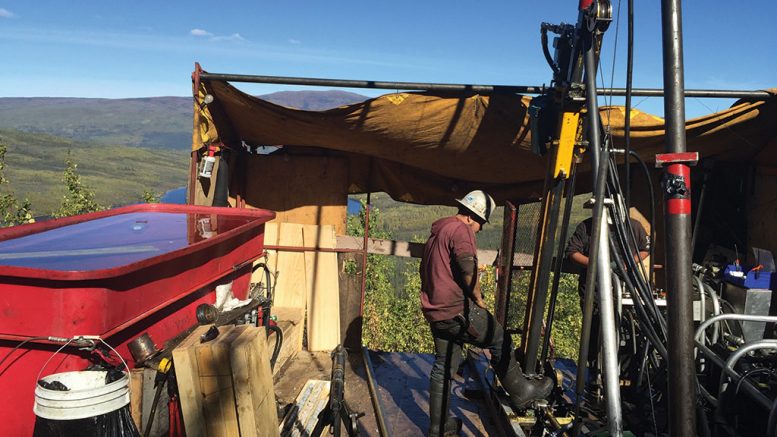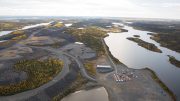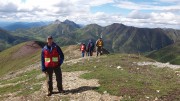Recent investments in the Yukon by Barrick Gold (TSX: ABX; NYSE: ABX), Newmont Mining (NYSE: NEM) and Agnico Eagle Mines (NYSE: AEM; TSX: AEM) underscore the allure of Canada’s Far North — where prospective ground and a bulletproof jurisdiction are proving a winning combination.
Barrick’s option agreement in April on ATAC Resources’ (TSXV: ATC; US-OTC: ATADF) Orion project, 100 km northeast of Keno City, follows Newmont’s investment in March in Goldstrike Resources’ (TSXV: GSR) Plateau project, 300 km east of Dawson City.
Those deals follow Agnico Eagle’s investment four months ago in White Gold (TSXV: WGO), which has staked more than 2,500 sq. km in the Yukon’s White Gold district, and Goldcorp’s (TSX: G; NYSE: GG) $520-million acquisition in May 2016 of Kaminak Gold and its Coffee gold project, 130 km south of Dawson City.
The investments are consistent with the strategies of the major mining companies to partner with junior explorers and identify and develop mining districts with exploration potential that will grow their net asset value per share. Politically stable jurisdictions like the Yukon are even more attractive to majors seeking to add high-quality ounces to their development pipelines.
“The majors like the fact that it’s Canada, a jurisdiction they’re comfortable in,” president and CEO of White Gold Corp. David D’Onofrio says. “They have pretty much all been burned in some capacity or another in foreign jurisdictions over the last five or 10 years. These foreign jurisdictions look good at the beginning, but don’t always work out the way you think they will.”
William Chornobay, Goldstrike’s chief operating officer, says the Yukon investments mark “the beginning of a new gold rush.”
In an interview, Chornobay says that “the senior miners are looking for near-surface, high-grade gold discoveries that are becoming extremely hard to find. The Yukon has vast expanses, with excellent untapped mineral potential.”
D’Onofrio says Agnico Eagle was not the only major kicking the tires at White Gold. “There were other majors interested at the time, but Agnico seemed to be the ideal partner,” he says. “Pretty much all the majors are looking to get a toehold in that area, so it’s a sign of confidence that there could be more to come.”
White Gold says it owns 30% of the Yukon’s White Gold district, with over 14,648 claims across 23 properties. Preliminary exploration work has generated several highly prospective targets and the claim packages are bordered by sizeable gold discoveries owned by companies such as Kinross Gold (TSX: K; NYSE: KGC), Goldcorp and Western Copper & Gold (TSX: WRN; NYSE-MKT: WRN).
Robert Carpenter, who founded Kaminak Gold, is a White Gold director, while Shawn Ryan, whose prospecting work in the Yukon has led to the discoveries of 7.5 million oz. gold, is the company’s chief technical advisor.

The Yukon River in the White Gold district in the Yukon. Photo courtesy of Shawn Ryan.
Ryan and his wife and business partner Cathy Wood made it big finding two large gold deposits near Dawson City. They optioned their first discovery, the White Gold project, 95 km southwest of Dawson City, to Underworld Resources in 2007, which was later acquired by Kinross Gold in a cash-and-stock deal worth $139 million. The couple optioned their second discovery, the Coffee gold project, 130 km south of Dawson City, to Kaminak Gold in mid-2009. The Northern Miner named Ryan and Wood “Mining Persons of the Year” in 2010.
Last September, Ryan agreed to option all of the remaining properties in the White Gold district (not in current joint ventures with third parties) to White Gold Corp., which was formerly known as G4G Capital. The properties range from grassroots targets where ridge and spur soil geochemical sampling could be used for follow-up exploration to more advanced targets, where grid soil geochemical sampling, mapping and geophysical surveys, and limited drill campaigns have been conducted.
Guy Gosselin, Agnico’s vice-president of exploration, tells The Northern Miner that several things about White Gold led his firm to take a 19.9% stake in the junior in December at $1.20 per share, such as White Gold’s enormous land position in an area of known gold deposits, and its technical team and exploration track record.
“We know there is gold in the area and we have the best people to find gold, because it’s basically what Shawn Ryan and Rob Carpenter have done in that part of the world,” Gosselin says. “They have all the ingredients.
“They already have a large database of information on that large land package, and on top of that, they have developed a cheaper way to explore with the rotary air blast (RAB) drilling process, so they can conduct a lot of work with a lot less money,” he continues. “They are moving less pieces of equipment and not using water to drill, so that makes their exploration process faster, and they are able to screen a lot of ground for less money than anyone else can.
“Shawn has been working in that part of the world for more than 20 years and has put together a good strategy, so we’re in a fertile environment with top-notch, quality people who will do a lot of work with the amount that we’ve invested, so for us and them, it’s a win-win situation,” Gosselin adds. “They will do potentially twice as much work with the money we’re going to put into it than we could potentially do ourselves, considering their skills.”

A foggy day in the Yukon’s White Gold district. Photo by Shawn Ryan.
Ryan’s Drones to Drills technology, which he invented and owns through his company GroundTruth Exploration, enables White Gold to explore year-round. The relatively inexpensive aerial drone surveys capture images that are combined to provide project-scale imagery at an ultra-high resolution and at a low cost. GroundTruth also developed the GT RAB drill — a remotely controlled, tracked platform that is entirely pneumatically and hydraulically operated, drilling at a cost of $135 per metre, or 70% less than the typical $450-per-metre cost of diamond drilling.
“Shawn and his GroundTruth team are achieving exploration at a quarter of the cost and in a quarter of the time that they were doing five years ago in 2011, so we’re able to cover a lot of ground,” D’Onofrio says.
For its part, Agnico says, if a discovery is made, it knows how to build mines in the North, having been in Nunavut since 2007. “We have the skill set to develop remote projects in that kind of location,” Gosselin says. “For us, it’s a continuation of what we undertook in Nunavut. All that part of northern Canada is highly prospective, and we’ll continue to monitor it and develop our projects there.”
Meanwhile, Newmont’s investment in Goldstrike Resources — the major’s first in the Yukon — marks yet another vote of confidence in the North.
In March, Newmont announced a US$39.5-million deal comprised of a private placement and staged work commitments to advance Goldstrike’s Plateau gold project in the central-eastern Yukon.

Washing down the discovery outcrop of the Goldstack zone at Goldstrike Resources’ Plateau South property in the Yukon in 2013. Credit: Goldstrike Resources.
Under the agreement, Newmont will make an initial US$4.5-million, non-brokered private placement in Goldstrike to buy 12.7 units at 47.42¢ per unit, and has a right to earn an initial 51% interest in Plateau by paying US$6 million in cash, spending at least US$13 million on exploration and completing a resource estimate. In the second stage, Newmont could earn another 24% by spending US$16 million on exploration and completing a feasibility study by 2027.
“We saw that for the amount of money we were going to put into it, there was potential for really good value in the future feeding our pipeline on the early-stage side,” Omar Jabara, Newmont’s group executive of corporate communications, says in an interview. “It made a lot of sense, and of course, the Yukon, as well as Canada, are good, friendly mining jurisdictions and have good infrastructure and laws, and contractual stability to support investment in mining, so in addition to being a good-quality resource, it’s also in a very good jurisdiction.”
Goldstrike’s Chornobay says initial drill results have been exciting, with widespread, high-grade gold mineralization found in a gold system that has a 50 km strike length, and remains open.

William Chornobay, Goldstrike Resources chief operating officer, examines a core sample from the Plateau South gold project, 300 km east of Dawson City in the Yukon. Credit: Goldstrike Resources.
The company made its first discovery at Plateau — called the Goldrush zone — in 2011, and followed it up with discoveries of the Gold Dome and Goldstack zones in 2012, and Goldbank in 2013.
Drilling at Goldstack in 2015 returned an intercept of 13.25 grams gold per tonne over 17.5 metres true width. Last year drilling at Goldstack produced a 45.5-metre intercept grading 6.05 grams gold per tonne, including 20.7 metres of 12.5 grams gold per tonne.
Newmont’s Jabara says that “we have some of the best geologists on exploration teams in the world at Newmont, and they have really good judgment when it comes to buying opportunities that have potential to deliver good value to the company. For them to come and bring this opportunity to management is an indication that they have more than just a good feeling. They also have some good data backing it up.”






13.25 grams gold per tonne over 17.5 metres true width. Last year drilling at Goldstack produced a 45.5-metre intercept grading 6.05 grams gold per tonne, including 20.7 metres of 12.5 grams gold per tonne.
Results like this one is a no brainer that Newmont wants a piece of the action
Is it in the same erea than Goldrush exploration program ?